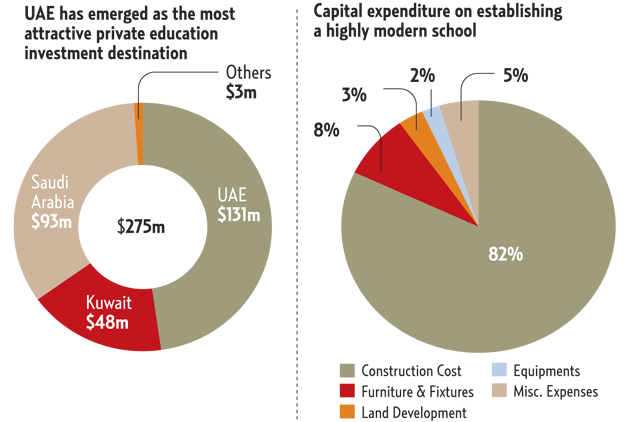
The business of education in the Gulf Cooperation Council (GCC) is growing fast and also getting more expensive.
Parents of 1.36 million expatriate students in the region shell out about $5.2 billion (Dh19 billion) in tuition fees through 4,400 private schools every year. However, this is a fraction of the region's education system, where 6.3 million students are enrolled every year in 35,000 schools, dominated by the public institutions, according to the latest report by research organisation Booz and Company.
"Private-school enrolment is expected to grow significantly in the GCC countries in the next decade, but governments and investors must overcome several key challenges in order to capitalise on the opportunities this will present," the report says.
Private education represents about 14 per cent of the GCC's $36 billion education market.
"Specific measures can help address these challenges," says Chadi N. Moujaes, a partner with Booz & Company.
"Governments should clarify the regulatory environment, ensuring that rules are stable and consistently enforced. Streamlining the most problematic regulatory issues, such as those regarding property ownership, would attract more education players to the market.
"Regulators may also reconsider tuition regulation in a way that balances consumer protection with operators' need to access funds. In addition, governments can raise awareness about market opportunities with more proactive communication to operators and investors, explaining the scope of projected growth in the region's private-school landscape."
The private sector enrolment in the UAE, valued at $2.8 billion, is among the GCC's largest education sectors growing 10 per cent annually, according to another research by Parthenon Group.
"With Western-branded higher education institutions in the UAE growing 18 per cent per annum, and UAE parents increasingly favouring international curricula at the school level, the opportunities for Western-branded schools to outperform the market are significant," Parthenon Group said in its report.
This, combined with a turnover of $160 million among schools offering Indian curricula and growing demand from South Asian parents, makes the UAE education sector ripe for investment. The study identified $5 billion worth of investment opportunities in education in the UAE and Saudi Arabia alone.
Karan Khemka, Partner and Head of the Emerging Markets Practice at the Parthenon Group, says: "Although the macro environment may suggest strong investment potential for education in the region as a whole, investors should choose their markets carefully; as different education sectors have different drivers.
"We identified several segments of the market that see exponential growth, while other segments might already run at full cap-acity. There is a clear trend in the region towards private education and a preference for international and mixed curriculum schools because stud-ents choose education in English at both the secondary and tertiary levels."
Public spending on education has increased over the years, with increased recognition to improve employability of the local populace. Saudi Arabia plans to spend $40 billion on education in 2011, up from $36.7 billion in year 2010.
According to data from the World Bank, public expenditure on education in the Middle East and North Africa (Mena) stands at 18.6 per cent of total government spending compared to the world average of 14.2 per cent.
Some regional governments spend more on education than developed countries as a percentage of GDP. Adult literacy rates in the region average a little over 80 per cent vis-à-vis the average of 97 per cent in developed countries. Most countries in the Middle East and North Africa (Mena) region offer an average 9.3 years compulsory education, which is low compared to the 12 mandatory years in developed countries such as the US and UK.
Only Qatar, Tunisia and Jordan have 10 or more years of compulsory education. Although Mena literacy rates have improved due to government initiatives, a lot still needs to be done, especially in the area of education for girls in countries such as Morocco, Egypt, Algeria and Tunisia, analysts say.
Factors
Three factors are likely to increase the scope of private education in the next few years, the research finds.
"Demographic shifts will increase the number of students — and thus schools — in the region. Parents' desire for higher quality education will increase the share of private education in the overall landscape," the report says.
"And their greater willingness to pay will increase the potential revenue pool."
Booz & Company predicts the GCC K-12 private school market will grow to between $11 billion and $17 billion by 2020 and enrolment will reach roughly 2.6 million.
A number of challenges must be addressed if the market is to achieve its potential. The shortage of qualified teachers is one obstacle in the way of growth. Leila Hoteit, a principal with Booz & Company, says that this is the first challenge to the private-school universe in the GCC.
"The global education sector is currently facing a worldwide shortage of talent, resulting in significant competition for well-qualified educators, particularly in international and Western curricula schools," she said.
"This competition is likely to intensify in the coming years, due to the expansion of "international" school offerings globally. GCC operators may not be able to match the lifestyle-related prerequisites available to expatriate teachers in competing markets, forcing them to either increase salaries or hire less-qualified individuals."
Land ownership is another challenge: Most GCC jurisdictions restrict foreign land ownership, requiring prospective private-school operators to go through the relevant private-sector regulator. This complex and time-consuming process is putting many off.
Immature market
It is also difficult for investors to find financing in a relatively immature market. Since several investors cannot own land, they cannot take out mortgages against it — meaning they must have sufficient free cash flow to fund construction on a 100 per cent equity basis, or sufficiently strong balance sheets to secure loans against other assets. The lack of public information about school quality is another problem.
Many authorities do not publish inspection results or other performance indicators, often because they want to ensure that systems are mature and operators are ready before taking this step. This restriction effectively leaves education consumers unable to differentiate between high-quality schools and low-quality offerings.
In addition, opaque regulations pose a challenge to be overcome, as many of the operating challenges facing private schools in the region are driven or compounded by a perceived opaque regulatory regime.
Moujaes says, "There is a notable perception among operators and investors that regulations are not applied or enforced consistently. Sophisticated investors outside the GCC express a very low tolerance for regulatory risk — a subject that has come up repeatedly in our interviews."
One of the biggest regulatory concerns for outside investors is the issue of tuition freezes. In most of the region, operators can set school fees as they see fit when they open a school, but must get approval from education regulators to raise tuition after that point. Current and prospective private-school investors have indicated that their inability to raise tuition revenue in line with cost increases has a significant negative effect on their interest.
Each of the key stakeholders in the GCC education system has a significant role to play in overcoming these obstacles and realising the education and market potential of the region's private schools.
First, regulators must provide some clarity surrounding property ownership requirements and zoning. Education authorities should improve their coordination with urban planning agencies to ensure sufficient quantity, location and size of plots for education use early in the master planning process to avoid the relegation of schools to inconvenient locations.
Regulators should seek to maintain consumer protection while redressing the supply imbalance. Although government regulation of tuition fees originated to protect consumers in a market where they had few choices, those policies may now be limiting consumers' choices by keeping investors from opening new schools. The first step for regulators will be to institute full transparency of tuition fee regulation — regulations that should seek to maintain consumer protection while still encouraging investment.
In addition to regulatory reforms, governments can proactively attract investors and operators to the market.
Business plans
Disseminating market information at a more active level can help, as many operators considering entry into the market have scant data with which to assemble business plans. Making this information public would help investors to reduce their risk profile, and would facilitate their evaluation and decision-making process.
Governments should also make school-performance data available in order to enhance competition in the marketplace, but it is essential for regulators to build the ratings' credibility with operators before publishing results.
Another element of support that governments can provide is to increase the supply of national teachers by establishing new kinds of teacher-training programmes.
Finally, governments can take steps to reduce the capital burden on investors by facilitating access to debt capital. For example, governments can work with financial institutions to increase access to debt financing for private-school operators, to eliminate the burden of 100 per cent equity financing, particularly for new developments.
Furthermore, given the extremely fragmented nature of the current market, operators should consider consolidation strategies.
High valuation expectations of individual owners need to be overcome. Consolidation, then, offers potential synergies.
Finally, operators should develop educational value propositions that resonate most directly with regional parental needs. In this way, investors will generate attractive returns, governments will develop more efficient workforces, and, perhaps most importantly, the region's students will receive the education they need to thrive in a more competitive global market.
Hoteit said: "Although the GCC's private school market may seem daunting to outsiders, more direct involvement in the market will show that governments are increasingly open to addressing its challenges, and in fact are transitioning from a strict regulator role to one more akin to a business partner. Sufficient communication — in both directions — will help create an environment in which all stakeholders can thrive."
Demand: Meeting international standards
The education market in the Middle East and North Africa (Mena) could be as high as $75.3 billion (Dh376 billion), Al Masah Capital said in its latest report.
With a population of 350 million, 60 per cent of which are below age 30 and 30 per cent under 15 years, a large and growing expatriate population that fuels the demand for private education at par with international academic quality standards, rising income levels and increasing urbanisation, it expects the regional education market to be around $75 billion, including $30 billion for primary and secondary education.
The region had an estimated 52 million students in 2009, which implies an average annual spend per student to about $1,450. Al Masah Capital said its estimate of the market size is based on the region's average GDP ($1.66 trillion), Mena governments' spend on education and statistics on public and private education spending as a percentage of GDP (public: 85 per cent, private: 15 per cent). The latest data from the World Bank indicates that Mena governments, on average, spend 3.8 per cent on education (GCC: 3.6 per cent, Mena Ex-GCC: 4.2 per cent).
Governments in the Mena region have made significant progress in primary level education. However, enrolment rates at the secondary and tertiary levels are significantly lower than the average in developed nations.
Improving the quality of education has become one of the top priorities of governments in the Mena region.
"Countries forming a part of Mena [particularly the ones that are hydrocarbon rich] have realised that they would have to invest in educating their future generations in order to ensure strong economic growth," said the report.
"Low literacy, poor enrolment at higher level of schooling, ill-qualified teachers, outdated curriculum and little faith in the overall system are issues still plaguing the education system."













